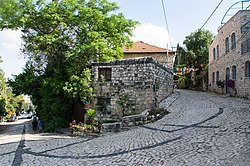 |
| a view of Old Rosh Pina, courtesy, Wikpedia (Hebrew) |
Rosh Pina is an Israeli town and local council in the Korazim Plateau in the Upper Galilee. It is situated on the eastern slopes of Mount Kna'an in the Northern District, roughly 5 miles north of the Sea of Galilee near the city of Safed. In 2019 it had a population of 3,148.
In Biblical
times, the site of Rosh Pina was allotted to the Israelite tribe of Naphtali. Centuries
later, during the Greek or Roman periods, a synagogue was built for the local inhabitants but it, as well as
the rest of the town, was later abandoned, probably during the Byzantine period.
Some time after the invasion of the Arabian caliph in the 7th
century, various Arab tribes arrived in the area and settled there. The site of
Rosh Pina was then established as the Arab village of al-Jauna. Beginning in
1878, Jews began to return to the area. In 1878, al-Jauna sold half its lands,
about 2,500 dunum, to a group of native-born Jews from Safed led by Elazar
Rokah. Settling in the newly-purchased lands, they called their settlement Gei
Oni ("Valley of my Strength") as a Hebrew adaptation of the Arabic
name. They fostered friendly relations with their Arab neighbors and often
allied with them when fighting off Bedouin raids. After one year of good
harvests, a year of drought saw the Arabs mortgage their lands to money
lenders, but the Jews were unwilling to do the same and left. In 1882, the
settlement was renewed as a moshavah by immigrants from Romania, who named it
Rosh Pina ("cornerstone") after Psalm 118:22: "The stone which
the builders rejected has become the cornerstone". A House of Dignitaries was built as a center of administration and
finance for Rosh Pina as well as for other towns in the Galilee region. From this building, a
loudspeaker was used to broadcast the local news. In 1883, the town became the
first to come under the patronage of the Baron Edmond
James de Rothschild. Rothschild's
agent Joshua Ossovetski expanded the settlement with not only more land from al-Jauna
but also from Safed. Eventually, about half a million grape-vines, and about 20,000
mulberry-trees would be planted. Rothschild's
gardens were
established in 1886, designed by a French landscape architect, with many plants
such as Bougainvilleas and pine trees that were brought
from France. Laurence
Oliphant, a Christian Zionist and mystic from Britain, had visited Rosh Pina and later collected
funds for the village from Christadelphians and other sympathizers in Britain. Good relations
between Rosh Pina and al-Jauna had continued to persist over the years and in
1899, a modern Arab school was built in al-Jauna, courtesy of the people of
Rosh Pina. Botanist Aaron Aaronsohn, while trekking around Rosh Pina during his 1906 field
trip, discovered wild-growing emmer wheat,
which was discovered to be the ancestor of most of today’s wheat grains. This
was an important find for agronomists and historians of human
civilization. The Mer house became
the home of Professor Gideon Mer, a Lithuanian Jew who had settled in
Rosh Pina in 1914. An expert on malaria and epidemiology, he was an important
contributor to the eradication of malaria in the 1930s.
During the
War in Independence in 1948, Rosh Pina became the location of Camp Philo of the Yiftach Brigade, a
unit of the Palmach, later absorbed into the Israeli Defense Forces.
Today, some of the local sites include: Ben Ya'akov Airport located 1 mile from the town; the Mifne Center, a program for the treatment of autism spectrum disorder; Mitzpe HaYamim, a world-class spa; PICA (Palestine Jewish Colonization Association) House, originally an administrative center and residence for Baron de Rothschild’s clerks, advisors, and agricultural counselors, today, provides an audio-visual presentation of the story of Rosh Pina; the Pioneers National Restoration Site in old Rosh Pina; and the old silk factory.
No comments:
Post a Comment